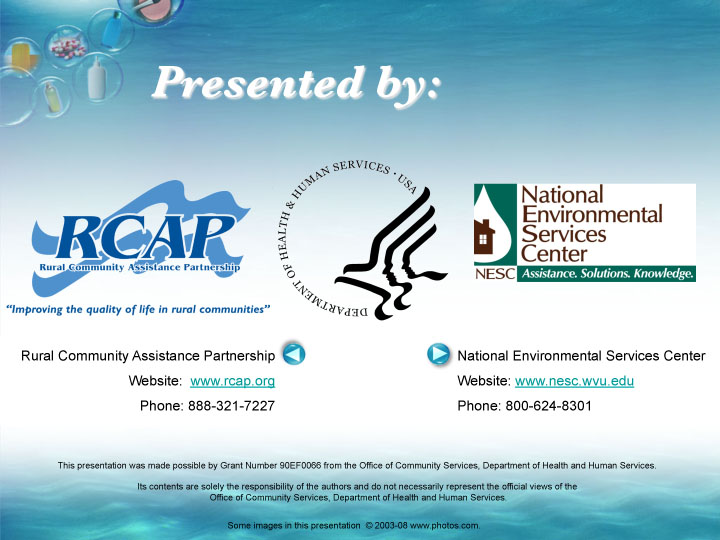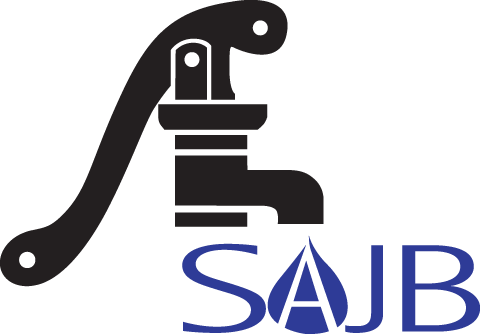What’s in our Water?
Do you know what’s in the water leaving your home?
Take a look at this presentation for some surprising facts about pharmaceuticals and personal care products (PPCP).
Do you know what’s in the water leaving your home? This presentation will show you some surprising facts about pharmaceuticals and personal care products.
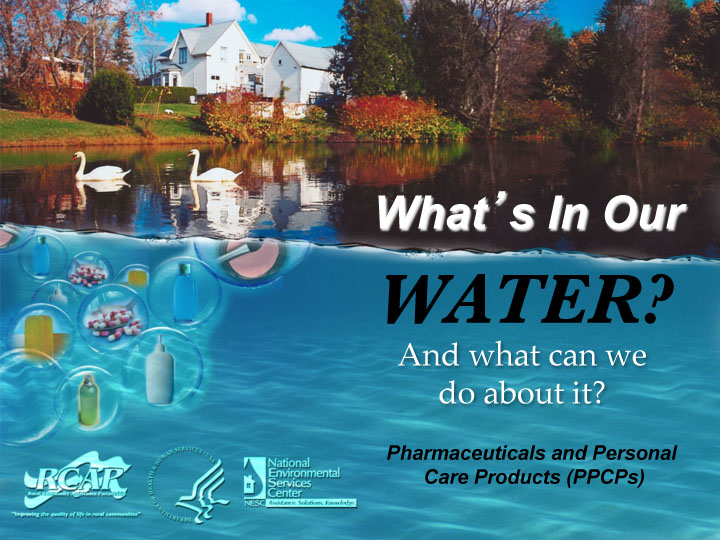
Our water comes from many sources. And the way we use it is just one part of a continuous cycle.
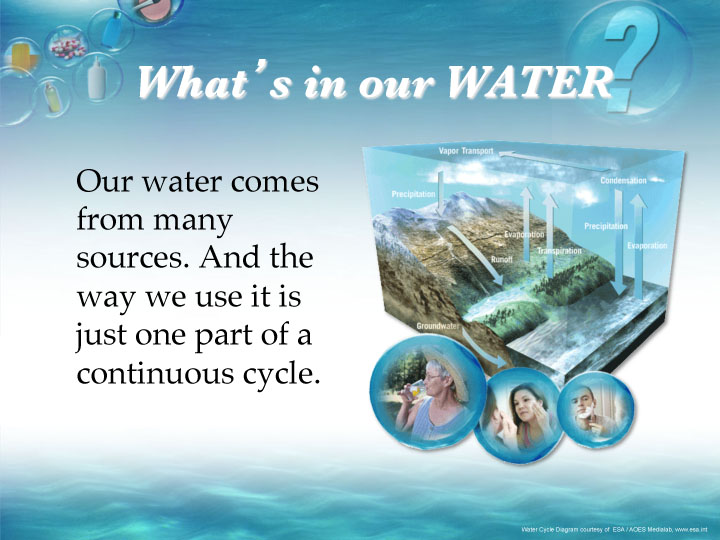
People don’t always associate the water in a river, lake, or underground well with the stuff we drink from the faucet. But we take water from these sources, use it for drinking, cooking, bathing, etc., and when we’re finished with it, it is returned to the local waterways. In most communities, the water that is flushed down toilets or drains travels first to a wastewater treatment plant where it undergoes several physical and biological processes before it is released back to the local waterway. The water is then picked up by the next community and used all over again.
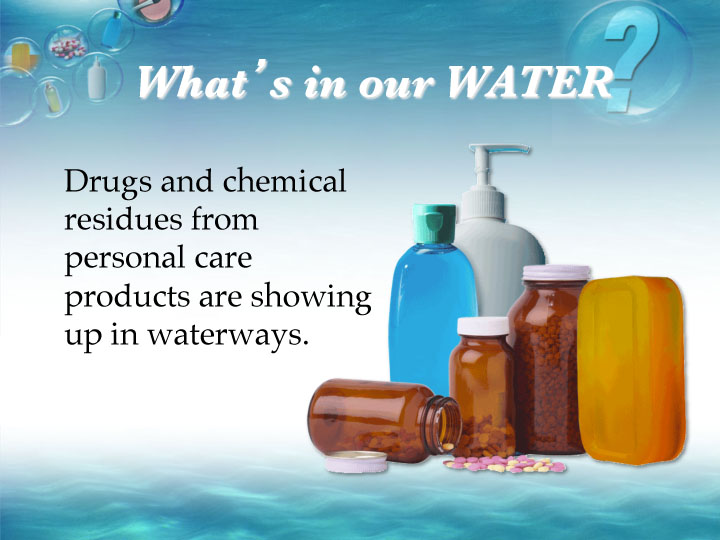
For years, it has been a common practice to discard unused or outdated medications by flushing them down the toilet. Consequently, a growing number of prescription medications plus chemical compounds found in personal care products, which include sunscreen, antibacterial soap, lotions and perfumes (that flow down the drain when we wash or shower) are being found in waterways across the country. These compounds are referred to as PPCPs (pharmaceuticals and personal care products), and they include a diverse collection of thousands of chemical substances. These substances can also enter the environment through leaching from landfills, runoff from confined animal feedlots, storm drain overflow containing raw sewage, and via straight pipes from rural homes.
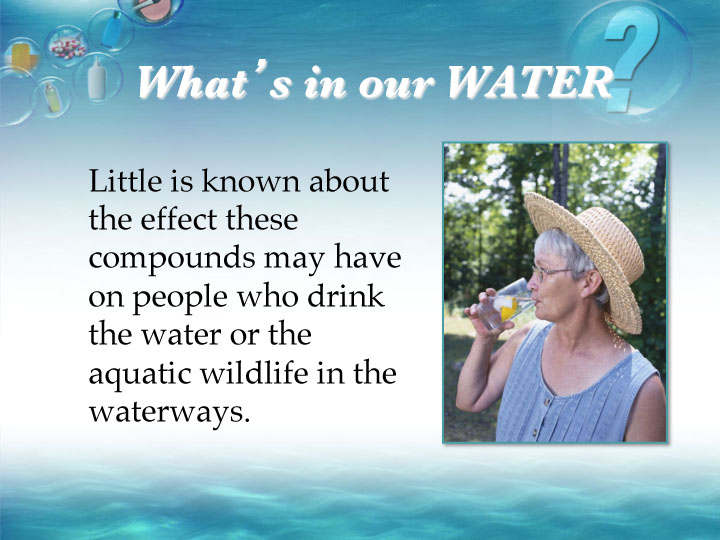
Researchers are trying to determine what effect these substances may have on underwater wildlife and their habitats and also whether there is any potential threat to human health. The U.S. Geological Survey conducted a nation-wide study of 139 streams and found low concentrations of numerous chemical compounds related to health management (both human and animal) and to personal care. The U.S. Environmental Protection Agency is currently exploring ways to curb the amount of pharmaceutical waste disposed from hospitals, long-term care facilities and veterinary hospitals. The EPA is also commissioning the National Academy of Sciences to determine the potential risk to human health from low levels of pharmaceutical residues in drinking water.
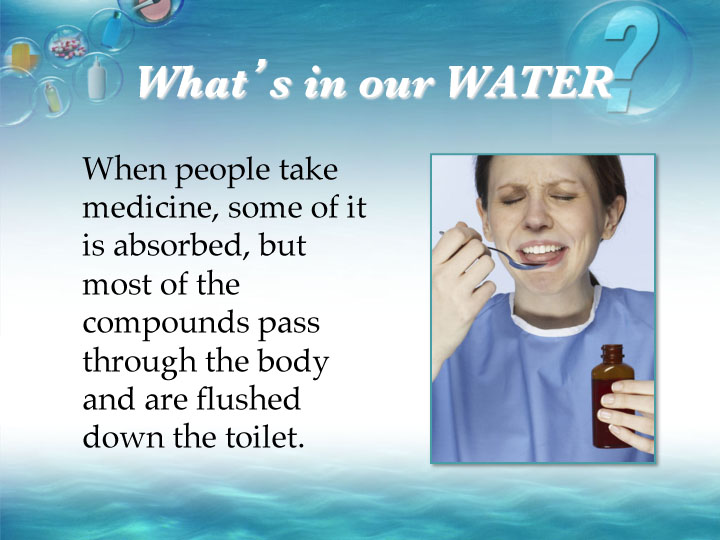
Medications for anxiety, pain, cholesterol management, asthma, epilepsy, and heart disease, to name a few, were found in drinking water sources across the country in a study conducted by the Associated Press (published March 10.2008). Every year the number of prescriptions written by doctors is increasing; $200.7 billion was spent for prescriptions in 2005, almost five times the amount spent in 1990.
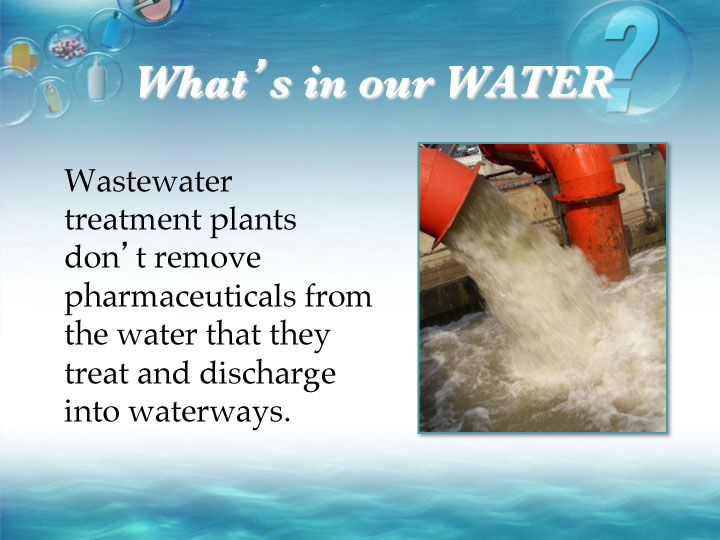
Wastewater treatment plants are not designed to remove drugs from the water. The physical and biological processes that clean the water are very efficient, but PPCPs fall outside of that realm. Homeowners who have septic tanks need to be especially careful about discarding unused medication in the toilet or down the drain because some compounds, like antibiotics, can disrupt the treatment processes and create a risk of groundwater contamination from the PPCPs and also from fecal matter.
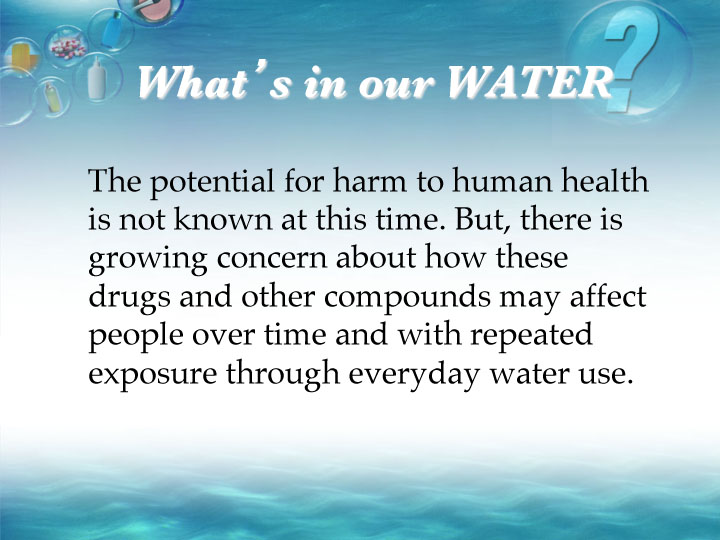
The compounds being found are trace amounts measured in parts per billion or trillion. These are small amounts, but no one knows how they may alter the natural biological processes in underwater plant and animal habitats. There is also concern that they may accumulate in tissues as they move up the food chain. With the number of prescription and over the counter drugs increasing, and with an estimated $35 billion of personal care products purchased every year by U.S. consumers, it makes sense that we should try to prevent as much of these PPCP compounds from entering our wastewater as possible.

One of the simplest ways individuals can help to prevent drug compounds from entering our waterways and drinking water sources is to dispose of them otherwise than via the toilet, unless the label or accompanying patient information specifically says to do so. Even though this method of disposal was recommended for years, the number and amount of prescription medications entering our nation’s waters is too great to be ignored.
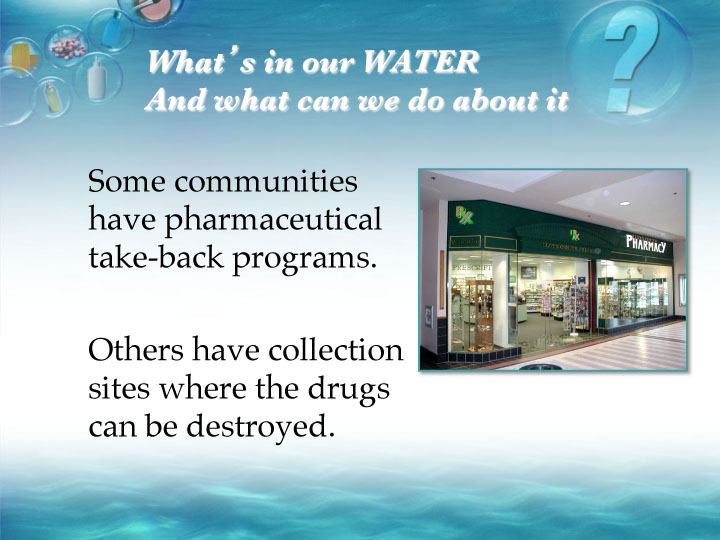
While these “community pharmaceutical take-back programs” and drug collection sites are rare, as awareness grows about the potential problems associated with medications in our waterways, more will be created. The case study reported in the Safe Drinking Water Trust newsletter in your handouts demonstrates one community’s way to prevent pharmaceuticals from getting into drinking water. The city of Bella Vista, Arkansas, bought a drug incinerator called the “Drug Terminator.” The Terminator, which is kept at the local police department, uses forced air to accelerate a wood-burning fire. A special injector chute pushes the drugs into the fire where they are destroyed.
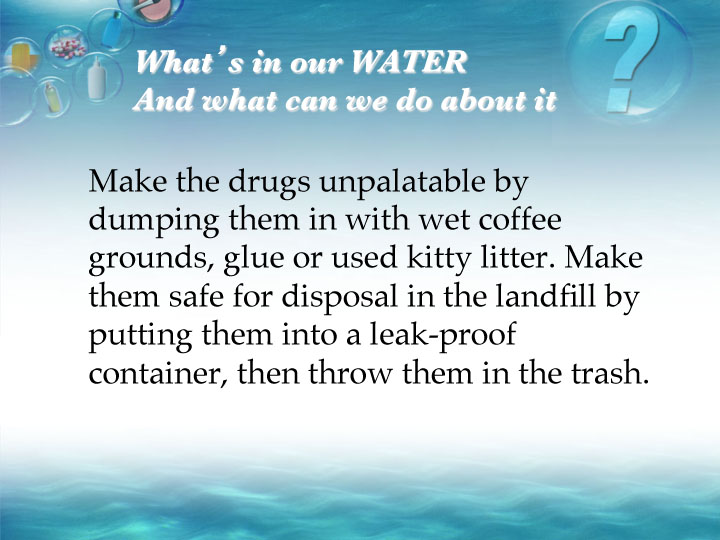
Disguising or destroying the integrity of prescription medications will make them unattractive to anyone who might find them in the garbage. Putting the medications into a plastic container conceals the contents. Although you would ordinarily want to recycle plastics, and although eventually the drugs may leach into the groundwater, this disposal method is recommended by the U.S. Environmental Protection Agency where no other safe means of destroying prescription medicines exists.
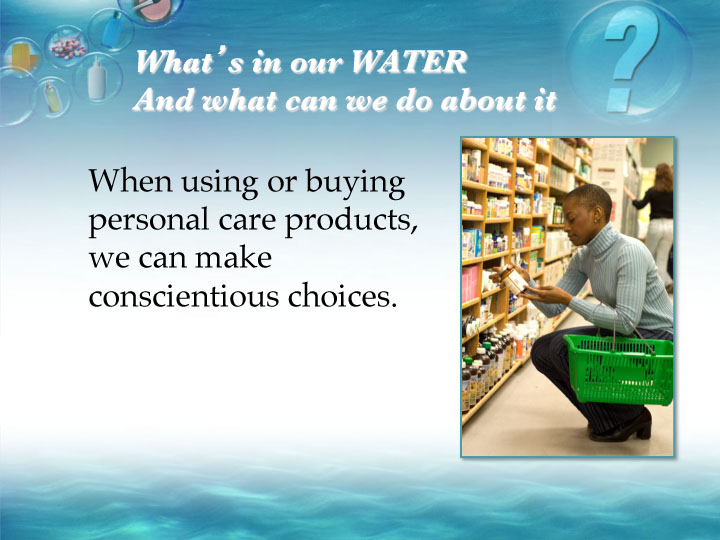
Personal care products create an entirely different problem, since they enter the water in a less intentional manner. Lotions, soaps, perfumes, etc., have become an integral part of day-to-day life. Although no one can expect for the population to give up their cleaning and grooming rituals, reducing the number of PPCPs brought into the home is a first step in decreasing the amount of contaminants that enter waterways. The next best thing is to make good choices when it comes to using, buying, and throwing away excess of these kinds of products.
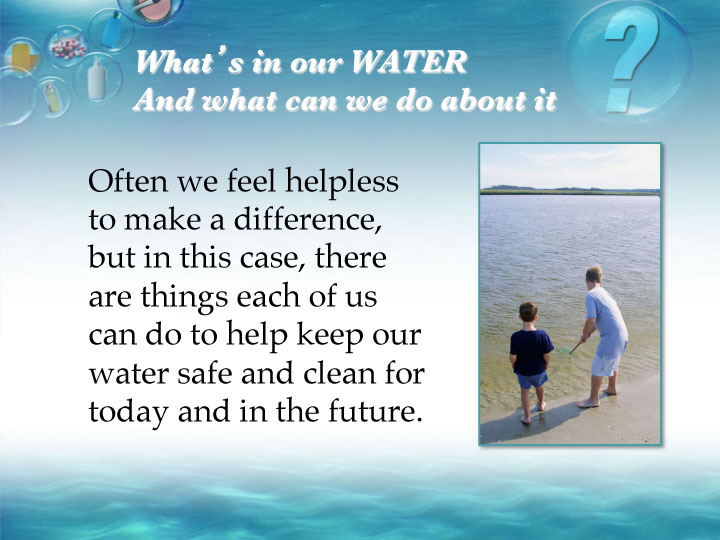
We hope you enjoyed the slideshow!
